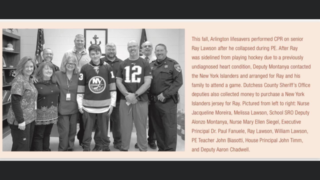
Stephanie Whitaker, Ray Lawson and Kyle Davidson gather after CPR saved Ray’s life.
It was Friday the 13th, and a full moon. That had Arlington High School nurses Maryellen Siegel and Jacqueline Moreira “quaking in our boots,” Siegel said.
“We’re not normally superstitious, but we do see differences when there’s a full moon,” she

News from the school district honored those who helped save Ray Lawson’s life.
said.
Still, it had been a relatively normal September day until some students ran in to tell the nurses they were needed because a kid had passed out. They grabbed their “go” bag and the AED and rushed to the farthest gym where the student had collapsed.
School Resource Officer and Dutchess County Sheriff’s Deputy Alonzo Montanya and his partner Aaron Chadwell had just walked out of Montanya’s office when the nurse’s secretary told them they were needed. They heard the 911 call go out that the PE teacher had placed.
Melissa Lawson and her young niece were on their way to pick up her son, then-17-year-old Ray, from Arlington High School to take him to DMV to register his car. En route, she got a call from the principal, telling her not to worry, that Ray hadn’t been breathing well and was on his way to the hospital.
Seventeen-year-old Ray Lawson doesn’t remember much from that day. He’d finished 17 laps of the Pacer Test, a physical fitness test required of students, and he had collapsed. His friend Stephanie Whitaker had run to get the nurse.
When Siegel and Moreira arrived in the gym, they began doing CPR and using the AED. When Montanya and Chadwell arrived, they also did CPR and checked on the AED pads.
“Ray was blue, and was agonally breathing,” Montanya said.
“Agonal breathing is gasping,” Siegel said. “I also felt for a pulse and there wasn’t one.”
The AED that the nurses had brought shocked Ray three times, in addition ot the continued CPR that the nurses and sheriff’s deputies performed until EMS arrived.
“The AED that EMS had also gave Ray a shock,” Siegel said. “By the time they put him on the stretcher, he was pink.”
Melissa Lawson took her niece to her own home, and Lawson’s brother drove her to the hospital.
“We got to the hospital before the ambulance,” Melissa said. “I remember asking, ‘where is the ambulance?’”
When the ambulance arrived, Lawson’s brother collapsed. By the time hospital staff brought Melissa to see her son, he was sitting up and talking. He didn’t remember anything that happened.
Ray was later diagnosed with hypertrophic cardiomyopathy, and had a pacemaker/defibrillator implanted.
“Jackie and I were relieved of duty after Ray was taken to the hospital, but we waited to hear what happened,” Siegel said. “We were so happy when we found out he was talking, alert and oriented.”
For the nurses and the deputies, Ray’s story is a happy ending they don’t see often enough. Only 10 percent of people who suffer sudden cardiac arrest outside the home survive. Having people who acted quickly – calling 911, getting people who knew CPR and getting the AED – made the difference.
“There was a lot of good teamwork and communication, and it was great that everyone had had the CPR and AED training,” Montanya said.
“That AED,” Siegel said, “was like a gift from God.”
“The AED makes the difference,” Montanya said. “You can learn to use it in five to 10 minutes. Think of all the things you do that take 10 minutes. This is an easy thing to learn.”
The American Heart Association passed a law in 2016 that requires all high school graduates to have learned Hands-Only CPR and AED skills.
“The more people that know this skill, the better,” Montanya said.
Ray was discharged from the hospital a week after his sudden cardiac arrest, and when he returned to school, staff, Ray and his parents held a re-entry meeting.
“I wanted to fly across the room and hug him,” Siegel said. Instead, when Ray left for his classes, she asked if she could hug him. He said yes.
“Then we took Mom back to the office, and we had a moment,” Siegel said.
Some things changed for Ray, who will be going to Dutchess County Community College in the fall. He had been a varsity hockey player and was only recently cleared to play at a much-less intense level. Yet, the team made him the all-star goalie. Arlington residents also put out lawn signs to honor Ray.
Montanya took it a step further when he learned that Ray is a New York Islanders fan. The Sheriff’s office bought him an Islander jersey, and Montanya reached out to the team to see what they could do for Ray.
“I just called them up and they were great,” he said. “They gave Ray great seats to a game, he got to meet some of the players, and they autographed his jersey.”
“Jackie and I talk about this all the time,” Siegel said. “People who suffer what Ray did don’t usually survive. But he was surrounded by people who knew what to do, and that made the difference.”
“We’ve met with people at the school, and Deputy Montanya checks in with Ray,” Melissa Lawson said.
“We’re all parents,” Montanya said. “It could have been any of our children. The Lawsons gave us Guardian Angel ornaments, and that ornament will be on our tree every year to serve as a reminder of Ray, his family, and how a small group of people with CPR and AED knowledge can make a difference at any time in any place.”